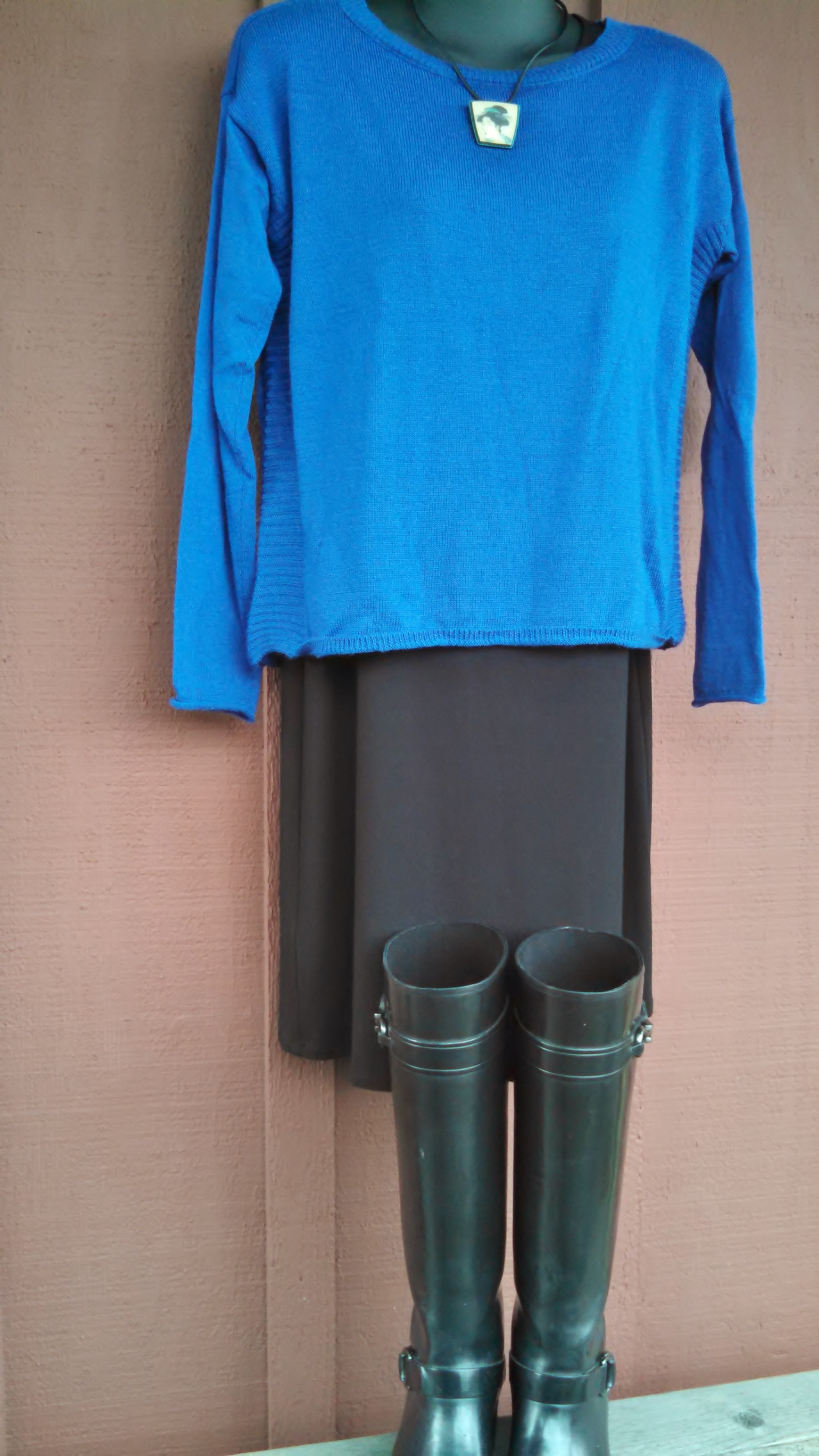Project 333 was a helpful examination of my lifestyle and shopping habits. I got a lot of compliments on my dresses, and enjoyed wearing them. Most of my dresses had languished in the back of my closet for years despite the fact that I really liked them and they fit well. The experiment helped me examine why this was the case and take steps to make better use of my garments.
The Reorg
First, to get dressed for a date with my husband required sorting through several drawers and a closet to find everything I needed. With my time constraints and lack of patience with the process, I simply didn’t bother to get dressed up. I used to store my clothes by garment type and color in my closet and dresser. While this type of organization allows us to store a maximum amount of clothing, we lose whole outfits in the process. I realized that separating my outfits was the crux of my problem. So, I started hanging my outfits together on hanging dress forms, including accessories. My shoes went below.
I also utilized the Japanese KonMari method of organizing, which requires that we retain only items that make us happy. By the end of this thorough process, I realized that I never wanted to purchase anything again unless I really, really needed it. Search for “The Life-Changing Magic of Tidying Up: The Japanese Art of Decluttering and Organizing” by Marie Kondo if interested.
I also hadn’t worn some garments recently because they required repair or alteration. My local dry cleaner replaced some spent elastic on a slip. My local cobbler fixed 4 pairs of shoes for less than the price of one new pair. A local department store and designer I tend to shop with also offer repair services for very reasonable fees. Handbag manufacturers are another avenue for maintaining our accessories. These services will save large sums of money and items from landfills by specializing in maintenance. Additionally, in light of the recent Great Recession, using repair services helps people stay employed, strengthening the economy without harming the financial well-being of the average person.
Future Directions:
The average American owns approximately 365 pieces of clothing, not necessarily including accessories. My total wardrobe, including clothing, shoes, and accessories is about 120 items, less than half the average. However, the retrofitted closets in my 100-year old house are small, and my accumulation feels gargantuan. My wardrobe is very functional overall, but I have a few extraneous items I will continue to wear for financial reasons, but not replace when worn.
The result of the experiment is that I realized that I need 3 classic outfits per season, and a few accessories. I also decided with my family life that white garments are not for me. In a smaller wardrobe, garments are in more frequent rotation, so I can’t afford to have my clothes spend a lot of time in the laundry. In addition to stain-resilient colors, having clothes that can be easily repaired and upcycled to other uses makes more sense economically and environmentally than garments which become outdated or fall apart after wearing only a few times.
I plan to add pants back into my outfits now, but keep a dress on rotation. My outfits for the coming Seattle winter season, December through February, are:
| Outfit # | Clothes | Accessories/shoes |
| 1 | Turtleneck, jeans, sweater, trench coat/down jacket | Scarf, rain boots, hat, gloves |
| 2 | Silk shirt, slacks, sweater, trench coat/wool coat | Necklace, flats, hat, gloves |
| 3 | Basic dress, sweater, trench coat/wool coat | Scarf/necklace, rain boots, hat, gloves |
Conclusion:
Transitioning my wardrobe and shopping habits required the kind of mental reprogramming that an experiment like Project 333 and the KonMari method accomplishes. The experiment emphasized that caring for good quality, classic garments pays for itself in the long run in multiple ways; it is a healthy response to solving some of our current problems of debt, garbage, and human misery.
Finally, here are some tips from my Project 333 experiment:
- A classic dress will give you a top and bottom for a better price than separates.
- Dresses are more forgiving than pants if your weight fluctuates regularly.
- Alter a garment you otherwise like if it fits incorrectly or the hemline is dated.
- Check with your clothing manufacturer or department store, for mending and repair services.
- Buy the best quality garments you can afford and mend them as needed to save money long term.
- Don’t buy or keep anything in your closet that doesn’t make you happy because you won’t wear it.
- Organize your wardrobe to best suit your lifestyle.
Clothing Care & Repair Resources:
http://www.slowfashioned.com/archives/5688
http://www.textileaffairs.com/docs/lguide.pdf
http://diyfashion.about.com/od/mendingandalterations/tp/Repair_and_Mend_Clothing.htm
http://www.realsimple.com/beauty-fashion/clothing-care/make-damaged-clothing-accessories-new
http://www.patagonia.com/us/patagonia.go?assetid=63753
http://blog.thelaundress.com/wordpress/recommended-resources-services/
https://www.ifixit.com/Device/Clothing
Textile recycling resources:
http://www.weardonaterecycle.org/
http://www.retexnorthwest.com/
http://www.grownyc.org/clothing
http://www.ecouterre.com/san-francisco-launches-city-wide-zero-waste-textile-recycling-initiative/
http://seattletimes.com/html/ecoconsumer/2018192489_ecoconsumer19m.html
http://your.kingcounty.gov/solidwaste/facilities/textile-recycling.asp
http://www.eileenfisher.com/EileenFisher/Behind_the_Label/Behind_the_Label/Green_Eileen.jsp
http://www.seattle.gov/util/EnvironmentConservation/MyHome/ReduceReuse/KeepoutofLandfill/index.htm
http://www.seattle.gov/util/EnvironmentConservation/MyHome/ReduceReuse/DonateorResell/index.htm

